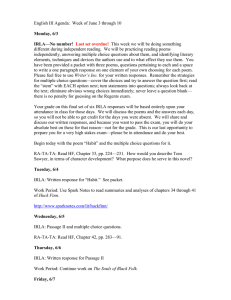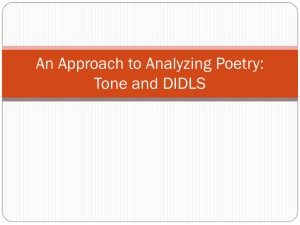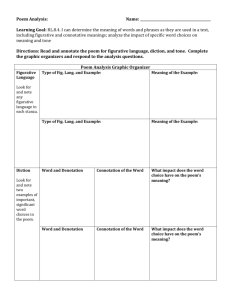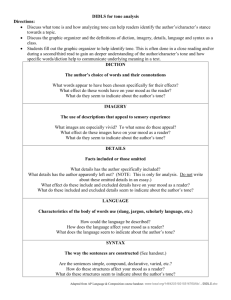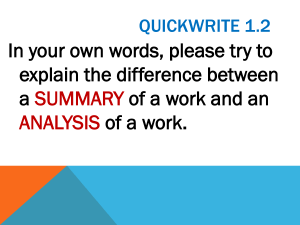A Life for a Life
advertisement
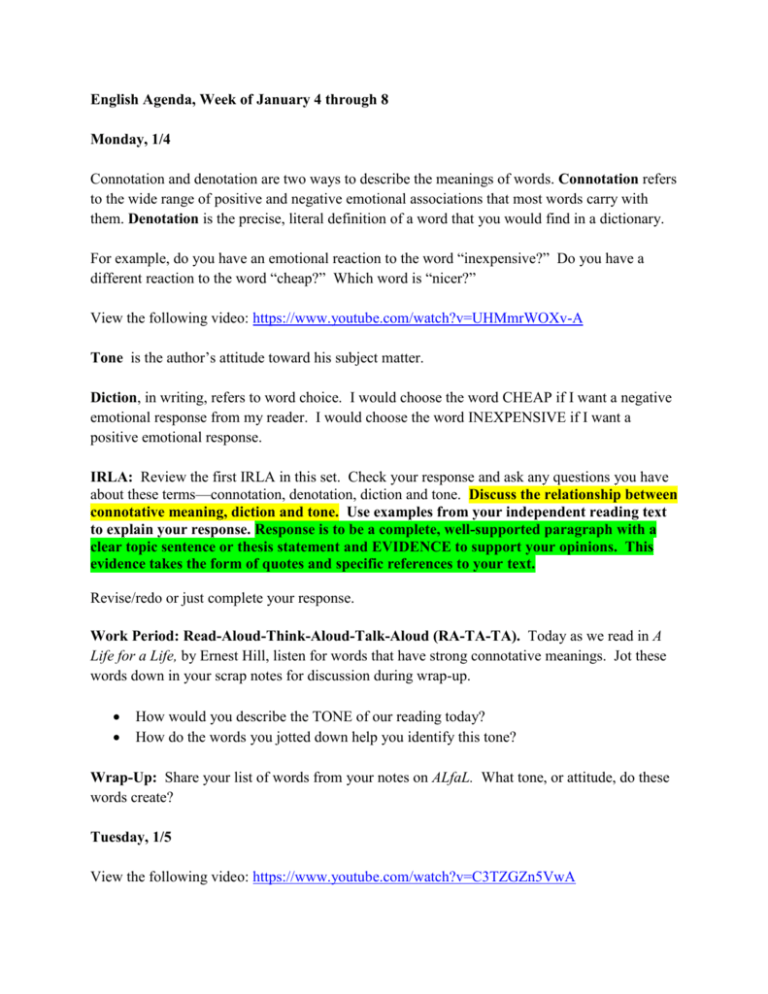
English Agenda, Week of January 4 through 8 Monday, 1/4 Connotation and denotation are two ways to describe the meanings of words. Connotation refers to the wide range of positive and negative emotional associations that most words carry with them. Denotation is the precise, literal definition of a word that you would find in a dictionary. For example, do you have an emotional reaction to the word “inexpensive?” Do you have a different reaction to the word “cheap?” Which word is “nicer?” View the following video: https://www.youtube.com/watch?v=UHMmrWOXv-A Tone is the author’s attitude toward his subject matter. Diction, in writing, refers to word choice. I would choose the word CHEAP if I want a negative emotional response from my reader. I would choose the word INEXPENSIVE if I want a positive emotional response. IRLA: Review the first IRLA in this set. Check your response and ask any questions you have about these terms—connotation, denotation, diction and tone. Discuss the relationship between connotative meaning, diction and tone. Use examples from your independent reading text to explain your response. Response is to be a complete, well-supported paragraph with a clear topic sentence or thesis statement and EVIDENCE to support your opinions. This evidence takes the form of quotes and specific references to your text. Revise/redo or just complete your response. Work Period: Read-Aloud-Think-Aloud-Talk-Aloud (RA-TA-TA). Today as we read in A Life for a Life, by Ernest Hill, listen for words that have strong connotative meanings. Jot these words down in your scrap notes for discussion during wrap-up. How would you describe the TONE of our reading today? How do the words you jotted down help you identify this tone? Wrap-Up: Share your list of words from your notes on ALfaL. What tone, or attitude, do these words create? Tuesday, 1/5 View the following video: https://www.youtube.com/watch?v=C3TZGZn5VwA IRLA: Review the second IRLA in this set. Check your response and ask any questions you have. Identify your author’s tone and discuss how diction helps to establish this tone. Be specific and use examples from your text to support your response. Revise/redo or just complete your response. Work Period: Continue working with your partner or in your small group on our notes on A Life for a Life. Review the organizational structure for notes (see Smart Board). You will be able to hold group discussions for the purpose of determining importance of details noted above. Rules for discussion: 1. Only one person speaks at a time. 2. Listen ATTENTIVELY as your peers speak. 3. Respond to what has been said before raising a new point. a. Ask a clarifying question. b. Ask the speaker to elaborate (provide additional information). c. Paraphrase what was said. d. When you disagree, disagree politely and with a clear explanation as to WHY. e. Come to group agreement about what to include (or exclude) in your notes whenever you are able to. You may want to keep select a group facilitator and timekeeper. Wrap-Up: One group, please volunteer to share your notes on setting and exposition. Wednesday, 1/6 View the following video: https://www.youtube.com/watch?v=nK-0lTV0wCA IRLA #3: How would you describe your overall MOOD as you read today? What words specifically contributed to that mood? Work Period: (RA-TA-TA). As we read today, continue to focus on plot and character details, but also consider the setting. In some classes, this setting will change. How does setting influence action? Wrap-Up: Do we have a definite antagonist in ALfaL? Who or what is it? Hint: How would you describe the primary conflict in the novel? Describe it. Thursday, 1/7 IRLA #4: Explain the relationship between tone and mood in your independent reading text. Use examples to support your analysis. Work Period: Continue working with your partner or in your small group on our notes on A Life for a Life. Review the organizational structure for notes (see Smart Board). You will be able to hold group discussions for the purpose of determining importance of details noted above. Review the rules for discussion: 4. Only one person speaks at a time. 5. Listen ATTENTIVELY as your peers speak. 6. Respond to what has been said before raising a new point. f. Ask a clarifying question. g. Ask the speaker to elaborate (provide additional information). h. Paraphrase what was said. i. When you disagree, disagree politely and with a clear explanation as to WHY. j. Come to group agreement about what to include (or exclude) in your notes whenever you are able to. You may want to keep your group facilitator and timekeeper or appoint new ones, depending on how you feel things went on Tuesday. Wrap-Up: One group to share your notes on our protagonist? Friday, 1/8 IRLA #5: Review—plot: A plot usually begins with a problem which the protagonist must meet or solve. During the story, tension is built through a series of complications, incidents which either help or hinder the protagonist in finding a solution. This is the rising action. Identify the primary conflict in your novel and discuss at least two incidents which either help or hinder your protagonist in his/her quest for a resolution. As always, your response is to be a complete, cohesive paragraph with a clear topic sentence and four-to-five supporting sentences which detail, illustrate or explain the topic sentence. Work Period: (RA-TA-TA). Objective—to note the primary conflict, at least one secondary conflict and one potential complication introduced in today’s reading of ALFAL. Continue to listen carefully and take notes—today listen for newly introduced characters and their characteristics. Wrap-Up: Write down one prediction you have for upcoming action in AlfaL. Be prepared to share this prediction and to explain what you are basing it on—solid analysis of character, setting, or action so far? Life experience? Volunteers to share? Your name Themes Your name Symbols Your name Plot Your name T1 Characters SY 1 Your name Per. ___ Mrs. Tassey Date A Life for a Life A novel by Ernest Hill P1 Exposition and Setting C1 E&S1
